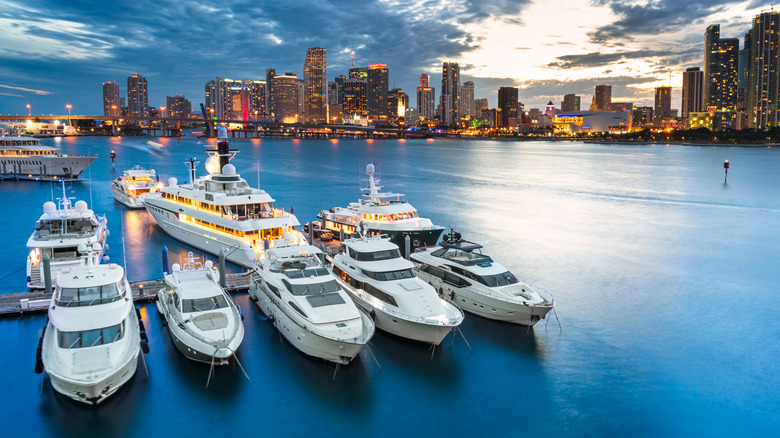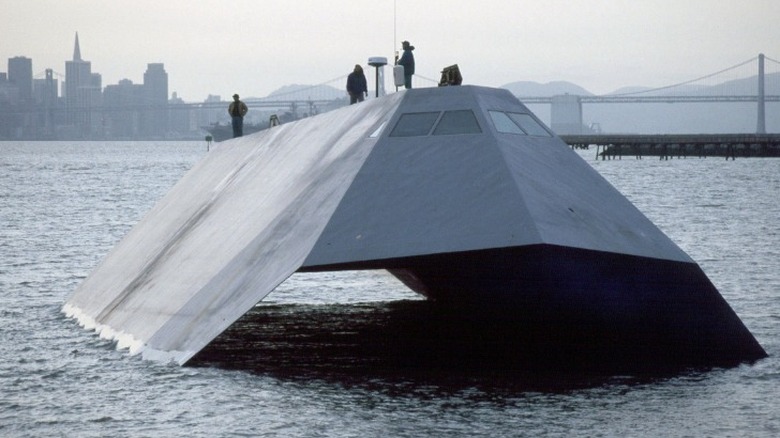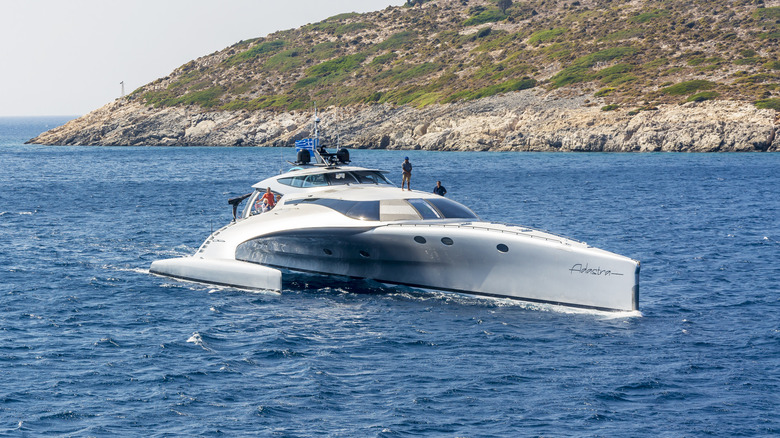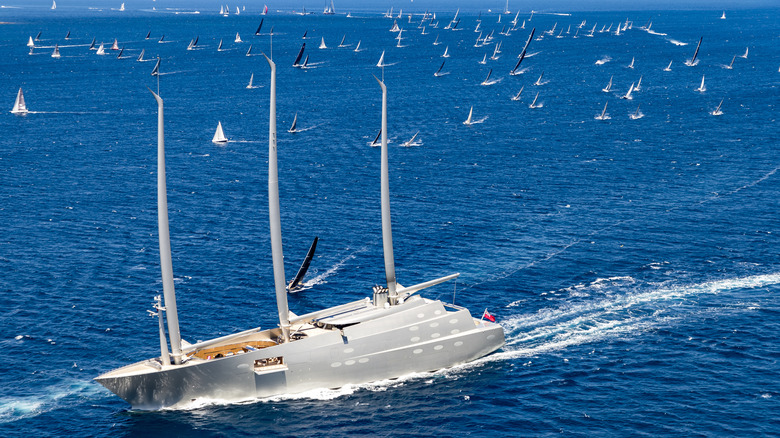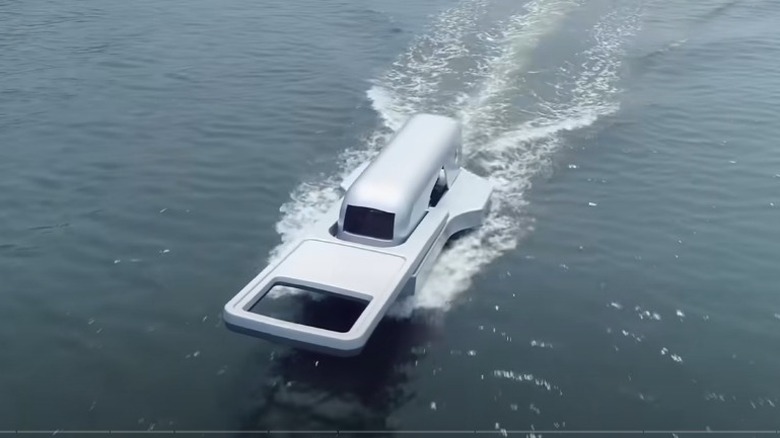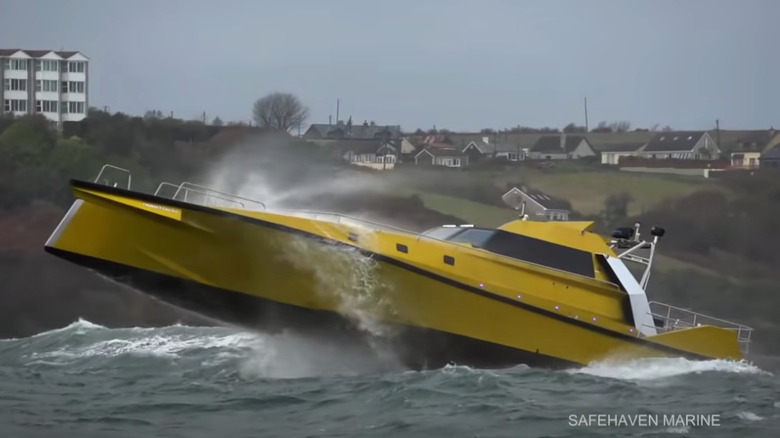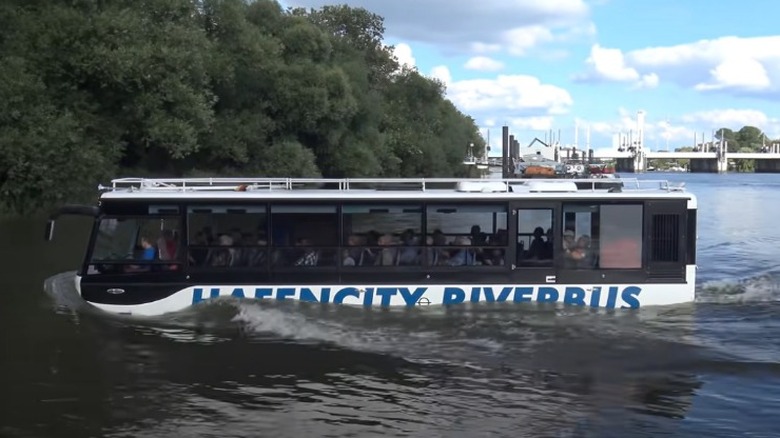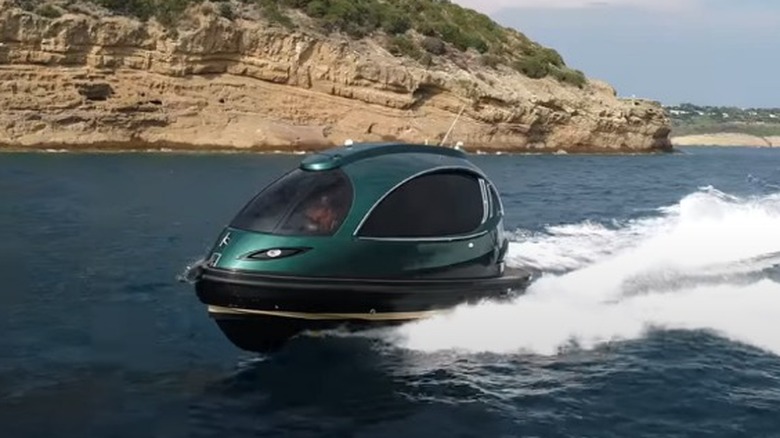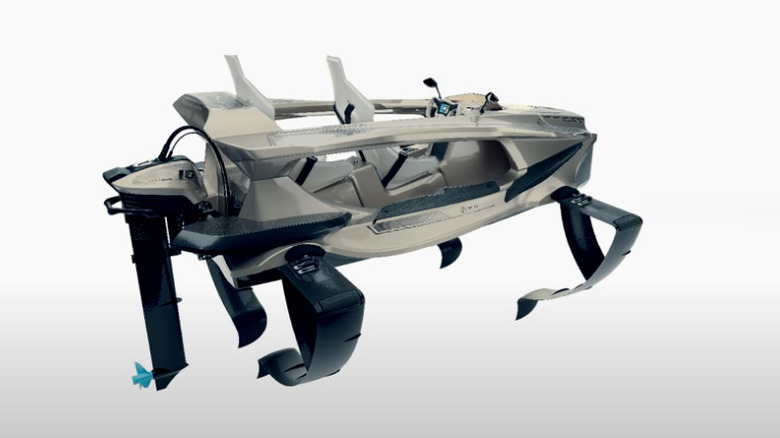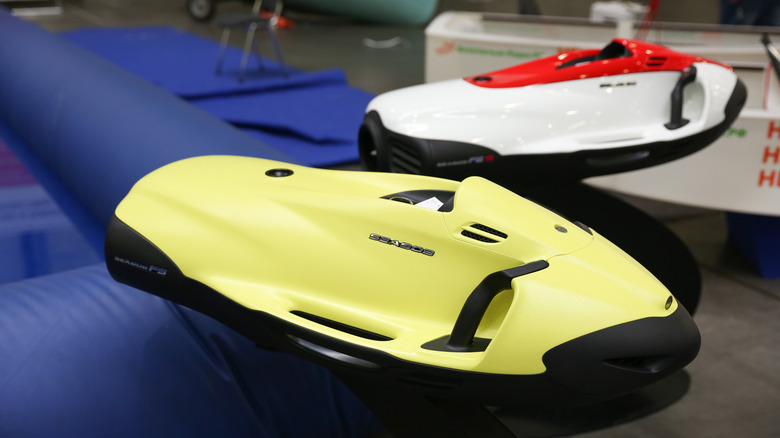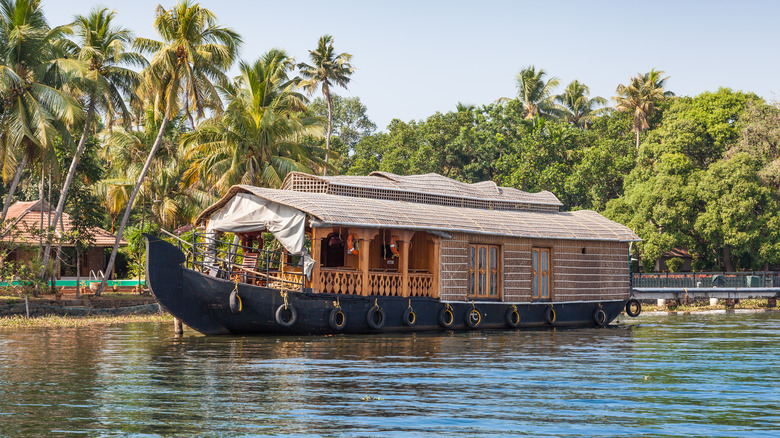These Weird Boats Will Change The Way You Think About Water Travel
Boats are not only a fun way to see the planet's bodies of water, but they are also useful tools for transportation and shipping. With a history stretching back to even before modern humans, boats come in as many varieties as there are distinct human personalities. Various cultures create watercraft unique to their own that are tightly linked to their geography — including ones that incorporate distinct cultural practices along with the variety of conditions present in their waterways.
In addition to the many types of widely-produced boats, there are even more varieties of individual watercraft, some cool and unique in the most useful and interesting ways, while others are just plain strange. As a creative endeavor, designing a boat not only helps its owners create something new, but it also helps them to engineer solutions to many problems while adapting the long-honored crafts of their ancestors. For the rest of us, it's great fun to explore these manifestations of the human spirit. Nowadays, there are even electric boats that draw comparisons to Tesla and autonomous vessels that can change shape. Here are ten weird boats for you to discover.
Sea Shadow
From their beginning, boats have served purposes of war, whether that be defending territory from invaders or striking out across the sea in search of conquest and acquisition of land. The biggest and most impressive vessels of all time have been hailed by the most powerful navies from ancient times until today. The U.S. Navy is the most powerful seafaring military organization in the world and looking through the US Navy's more than 200-year history, we can find many examples of the organization pushing forward seafaring as a form of national defense.
The Sea Shadow was a Cold War era experimental craft that borrowed ideas from the highly successful F-117 Nighthawk stealth aircraft. The stealth materials used in the Nighthawk to defeat radar detection could likely be applied to evading sonar, as well. Lockheed Martin built the Sea Shadow in secret and produced a menacing-looking object that would glide above the waters, buoyed by two long runners on either side of the ship, similar to a catamaran. It is known as the Small Water Area Twin Hull (SWATH) ship, and the design makes it much faster and more stable than conventional boats, according to Lockheed Martin.
Only one was ever built, and, while it had great potential, the results of sea trials were disappointing. The crew experienced atypically large wakes, found to be a cause of backward-installed propellers. While that issue was quickly corrected, the ship never went into production and was scrapped in 2006, according to DARPA.
Adastra
The Adastra yacht is equal parts weird and cool. With the recent proliferation of ultra-luxury yachts, new designs have come out of the woodwork to challenge the traditions of high-end shipbuilding. Boat International describes The Adastra as a blend of superyacht and spaceship and lists it as a 42.6-meter (139.8 ft.) trimaran, a boat with three hulls, with a range of 10,000 nautical miles. It is propelled by two huge Caterpillar C18 engines producing 1,150 horsepower each. In short, this trimaran is powerful and impressive.
The boat's designer explains the reason for its unique shape is to streamline the portion of the hull traveling through the water. The thin triple hulls create much less fluid resistance, allowing those diesel engines to push it quickly through the waves and wakes. The Adastra is not just built for speed, though. It is a luxury cruiser. The interior is brimming with luxury building materials and cutting-edge design. Furthermore, the furnishings and accouterments rival the finest of hotels anywhere in the world. Its size may be dwarfed by other luxury yachts, but its speed and stability make it comfortable with less time between ports. Travelers on the Adastra are a small but lucky — and quite wealthy — group of people.
Sailing Yacht A
Huge luxury yachts are not an uncommon sight in the world's most desirable travel destinations such as Monaco and the Virgin Islands. These are typically powered by large diesel engines and burn an extraordinary amount of fuel. Sailing Yacht A is quite unconventional, and the reason is present in its name. Sailing in the modern era is generally confined to small pleasure craft. Some sailboats are as small as 14-foot catamarans while others reach sizes that can accommodate sleeping quarters, a galley, and some degree of common area. Sailing Yacht A dwarves all of these other sailing vessels by orders of magnitude, being the largest sailboat in the world, according to Super Yacht Times. It is also likely the most technologically advanced sailboat on the seas.
While it requires a crew of 54, few, if any, need to be at the ready to handle any of the sail riggings. This boat uses electronic controls to hoist and direct the sales automatically on its custom-made carbon fiber masts. The carbon fiber construction makes them extremely strong with minimal weight. Everything about this vessel is unconventional, except for the price. According to Financial Review, the original cost of the boat is just shy of $800 million, however, its owner will not be using it anytime soon as it was seized in March of 2022 by authorities as a result of international sanctions against Russian oligarchs.
The Zipper Boat
Not all unique or weird boats have to be big, expensive, or capable of blowing your boat to pieces. Sometimes they can be just fun, as is the case with the Zipper Boat. Originally conceived as a sort of moving art project, Gizmodo says that Japanese artist Yasuhiro Suzuki designed and built the boat, first taking it to the water in 2010. The name of the craft is apt as its shape is literally that of a traditional YKK zipper.
Suzuki's inspiration for the boat came from his viewing of boats traveling on the water with their wake resembling a zipper opening up on a piece of clothing. Therefore, when Zipper Boat traverses the rivers of Japan, it looks as if it is zipping open the water. The boat was originally developed as a local art installation in his hometown on the Sumida river. It has continued to unzip the waters of Japan, most recently as a part of Tokyo's DESIGNART festival in 2020.
Thunder Child II
For those needing a boat for use in extreme conditions, the Thunder Child is an excellent choice. Designed and built by Safehaven Marine, the Thunder Child is built to be one of the fastest vessels on the water, but also able to navigate in extreme conditions thanks to its ability to right itself in nearly any circumstance. No matter how this boat gets knocked around from waves or storms, it will end upright. The manufacturer designed it for naval and law enforcement applications. It can accommodate a crew of 10 with six shock mitigation seats and four fixed seats, and has accommodations for sleeping. While it was designed for institutional use, it can be bought for private or commercial use as well.
Its specifications include a full roster of equipment and features including electronic communication equipment, satellite navigation, sonar, thermal cameras, and four 650 horsepower caterpillar diesel engines, all supercharged and turbocharged. The top speed is 54 knots, and the hull is designed specifically to cut through waves, leading to limited pitch and roll of the vessel. Its ability to right itself is the most impressive of its features (via Baird Maritime). This Irish-manufactured boat is packed with impressive technology, but it does not come cheap — the price of entry hovers around $1 million.
Duck boats
The naming of duck boats is a bit confusing, as they have nothing to do with waterfowl. Today mostly used for purposes of tourism, duck boats originated during WWII. These tourist vessels are mostly refurbished GM DUKW amphibious landing craft, developed to move troops and supplies onshore. Their amphibious abilities allowed supplies to be moved from the water without the need for the supply ship to dock anywhere. According to Pontoonopedia, these vessels first saw use during the invasion of Sicily and subsequently moved 3 million tons of soldiers and equipment during the war.
These former military vehicles are not commonly seen full of tourists on scenic waterways. Boston Duck Tours provides a popular way to see some of America's most historic sites from land and water. Boats run tours on the historic streets in the heart of the city as well as stretches spent on the Charles River. The popular midwest tourist destination of Branson, Missouri, has long ferried passengers through the town and onto Table Rock Lake in the Ozarks. However, tours were put on hold following a tragic accident in Branson caused the death of 17 people, according to KOLR news. Boat tours have since resumed with a new operator claiming the use of safer, upgraded boats.
Riverbus
While Boston may have the duck boats, Hamburg, Germany, has the Riverbus. Tourists to the river port city of Hamburg can see the sights on the MAN Hafencity Riverbus, a unique amphibious traveler capable of carrying passengers on and off land in the comfort of a modern city bus. Boat Mag International says the Riverbus is built on a MAN bus chassis with a custom-built body from Hungary.
The Riverbus is currently set up to do tours of the city, and it has been wildly successful. Hamburg is near the ocean with the Elbe River giving it direct access to the sea. With its history as a port city, most attractions are clustered around the river, which makes an amphibious vehicle perfect for taking in all the sights. The Riverbus carries up to 36 passengers and carries them on an 80-minute tour in modern comfort. Speed on water reaches seven knots and travel safely in traffic on the road, per Focus Transport.
Jet Capsule
Jet Capsule is one of the most interesting small watercraft to come out in recent years. While most small boats are open, the Jet Capsule is fully enclosed. It looks like some kind of futuristic pod skipping across the water. Jet Capsule launched in 2015 with models that included bench seating for six plus the driver, an open rear hatch, and an accessible sundeck on top.
The vehicles have since grown a bit, become fully enclosed, and now feature sprung captain's chairs to absorb the waves in comfort. The new top-of-the-line model also includes air conditioning, a wet bar, and an onboard toilet, making extended excursions luxurious and convenient (via New Atlas). The party trick for this pint-sized luxury cruiser is its propulsion system. The Jet Capsule is propelled by a Rolls Royce jet drive driven by dual Yanmar diesel engines and can reach a speed of up to 62 knots, or 71 mph across the water. Gaining this much speed on the water is not for the faint of heart or those of meager means. The retail price is about $285,000.
Quadrofoil
Another cool and unique watercraft meant for smaller parties is the Quadrofoil. This watercraft could be considered analogous to an open-top sports car for the water. However, it is not exactly a boat because it rides above the water on four hydrofoils, which act in the water much like a wing of an airplane does in the air to create lift. The hull of the Quadrofoil rides above the water, significantly reducing the amount of drag encountered by the whole vessel.
Originally introduced in 2014 for $28,000, the Quadrofoil is an electric-powered watercraft that glides effortlessly across the water at speeds up to 25 mph. The Slovenian manufacturer uses an electric motor of its own design and a next-generation lithium-ion battery that can be fully recharged in three to four hours. Particular attention was paid to ergonomics such that the Quadrofoil is fun but also easy to use and comfortable.
Seabob
Calling the Seabob a boat is stretching the English language to its limits. Seabob is often referred to as a sea scooter, as it's not so much a boat as it is a motor to drag you through the water. It is a unique method of propulsion through the water and looks to be about as much fun as anything can be offshore. The Seabob is a relatively compact contraption that houses batteries and powerful E-Jet Power Drive System, according to the manufacturer.
Driving with the Seabob is a fairly simple and straightforward undertaking. It has two handles, one of which has a trigger. To get going, you get in the water, grab the handles, pull the trigger, and the Seabob will drag you through and under the water for up to an hour. It is personal water transportation at its most basic, but when punching off from white sand beaches into clear ocean water, nothing could be more sublime. Dive in gave it a perfect score in its review, noting the highlights of good construction and ease of use. Its biggest downside may be the price, with a range of $10,000 to $20,000, depending on the model.
Kettuvallam
Living on the water is nothing new, but some may not know just how long humans have been doing it. The southern Indian state of Kerala has a unique culture closely tied to the water, as it borders the Indian Ocean and features large Mangroves with beautiful scenery. Some here have been living in the mangroves of Kerala on unique houseboats called Kettuvallam for millennia (via Culture Trip).
Houseboats are found in many parts of India, but the boats of Kerala are not typically permanently moored as they are in the other areas. The modern Kettuvallam is built using traditional methods, put together only with lashings and not a single nail or screw, just as they have been for generations. Modern Kettuvalium can be as long as 100 feet and offer rather luxurious and spacious living within. The natural bamboo materials used are robust and sustainable and many vessels are furnished with luxury furniture and home decor, Culture Trip notes. Curious travelers can book tours of the area on special Kettuvallam prepared for tourists who can experience a surprisingly upscale journey.
